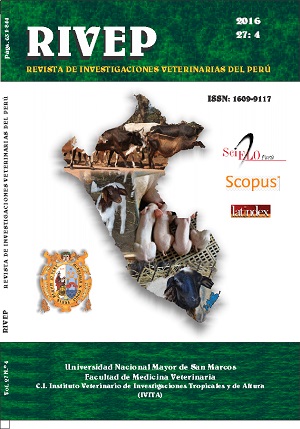Frequency of Toxoplasma gondii in technologically advanced pig farms and sex as a risk factor
DOI:
https://doi.org/10.15381/rivep.v27i4.12565Keywords:
Toxoplasma gondii, toxoplasmosis, cerdo, inmunofluorescencia indirectaAbstract
The aim of the current study was to estimate the frequency of pigs from technologically advanced farms positive to toxoplasmosis and to evaluate the association between positive reaction and sex of the animal. Blood samples were collected in 240 animals in a slaughterhouse in Lima, Peru. Samples were analyzed by the indirect immunofluorescence assay (IFA). The frequency of pigs positive to toxoplasmosis was 21.7%. Sex as possible risk factor showed an Odds Ratio (OR) of 1.24 with confidence intervals of 0.88-3.06. It was concluded that there is an important frequency of positive pigs to toxoplasmosis and that sex has no influence in the presentation of this disease.Downloads
Downloads
Published
Issue
Section
License
Copyright (c) 2017 Toxoplasma gondii; toxoplasmosis; pig; indirect immunofluorescence assay

This work is licensed under a Creative Commons Attribution-NonCommercial-ShareAlike 4.0 International License.
AUTHORS RETAIN THEIR RIGHTS:
a. Authors retain their trade mark rights and patent, and also on any process or procedure described in the article.
b. Authors retain their right to share, copy, distribute, perform and publicly communicate their article (eg, to place their article in an institutional repository or publish it in a book), with an acknowledgment of its initial publication in the Revista de Investigaciones Veterinarias del Perú (RIVEP).
c. Authors retain theirs right to make a subsequent publication of their work, to use the article or any part thereof (eg a compilation of his papers, lecture notes, thesis, or a book), always indicating the source of publication (the originator of the work, journal, volume, number and date).










